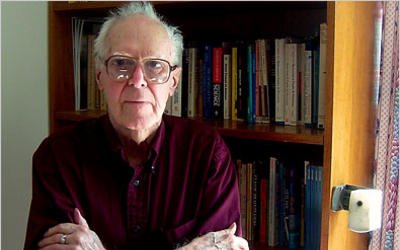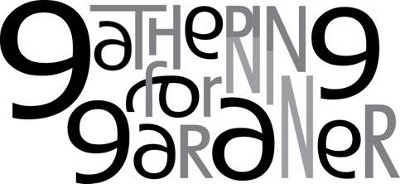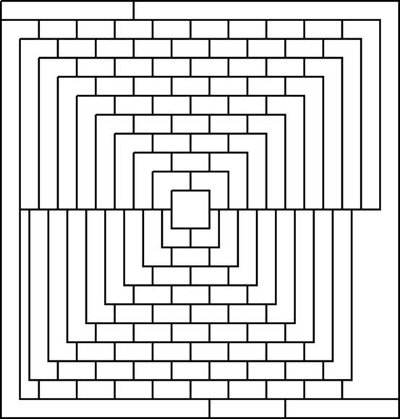The incomparable Martin Gardner
by Burkard Polster and Marty Ross
The Age, 4 October 2010

It's been a bad year for our mathematical heroes. First, the brilliant teacher Jaime Escalante passed away. Then we lost the incomparable Martin Gardner.
We have previously written about Martin Gardner, the all-time champion populariser of mathematics. His wonderful column, Mathematical Games, ran in Scientific American from 1956 until 1981. You can access a few of his most famous columns here, and the collected columns appear in a dozen or so books.
It is impossible to describe here the breadth of ideas covered in Gardner's hundreds of columns. The topics range from the simple games, through to tricky and clever puzzles, through to the exploration of deep and subtle mathematical concepts. All of it is beautifully written.
It is also impossible to overestimate the effect that Gardner's columns have had. Literally thousands of young mathematicians, two generations' worth and counting, have been inspired by Gardner's writings. For a number of them, it was the single most important reason why as teenagers they chose to pursue mathematics. His books are must-haves for every library.
Though playful, and intended for a quite general audience, Gardner's columns were often inspired by new mathematics, and they often inspired it as well. Indeed, your Maths Masters spent a fair amount of time pondering a tricky question of balancing wobbly tables, which you can read about here and here: all this investigation was based upon an idea from a 1973 Gardner column.
Amazingly, Gardner was self-taught, with essentially no formal training in mathematics. He never described himself as a mathematician. However, Gardner was a brilliantly clear thinker, a master at capturing the essence of an idea. You can watch Gardner, and some of the great mathematicians he inspired, in this terrific documentary.
And it was not just mathematics. Martin Gardner produced much, much more than his column. He wrote more than 100 books, many with only a very general connection to mathematics. Indeed, our clear favourite Gardner book is The Annotated Alice. We, along with almost everyone, have always adored Lewis Carroll's Alice in Wonderland. However, Gardner's brilliant explanations and elaborations add a whole new dimension to Carroll's fantasy masterpiece.
Gardner was also an avid magician. So, with his combined interests in clear reasoning and sleight of hand, it is unsurprising that Gardner was a keen debunker of wooly thinking and silly theorising. The science education boom of the 1950's was accompanied by all manner of pseudoscientific nonsense, and Gardner was an early, energetic and incisive critic. He was one of the great driving forces of modern scepticism.
Martin Gardner never slowed down, writing four books after having turned 90. But in any case Gardner had already inspired an army of like-minded spirits to follow him, including your Maths Masters. And soldiers in this army began to gather, under the banner of Gardner's name.
The meetings known as Gathering4Gardner began in 1993. They are now held every two years, attended eagerly by mathematicians, magicians, puzzlers, popularizers, and anyone interested in the celebration of clear and beautiful thinking.

G4G9 was held earlier this year, and was attended by such superstars as mathematician John Conway, Mathematica's Stephen Wolfram, and master illusionist Al Seckel. And, your Maths Master Burkard Polster was also privileged to attend. The Gathering featured tons of ingenious mathematics, origami, Escher-like art, computer hacking, puzzles, mazes, mathematical art and architecture, juggling ... and the giant "snub dodecahedron" made from balloons, pictured below. In brief, G4G9 was a blast.

Martin Gardner was born on October 21, 1914, and died on May 22, at the age of 95. He lived long, and produced enough for ten long lifetimes. Now, the proposal is to have an annual Celebration of Mind, each year on Gardner's birthday, with such celebrations taking place all around the world.

In conjunction with the Mathematical Association of Victoria, we are delighted to assist Melbourne in being part of this Celebration. If you would also like to be part of this free event, please register, and join us in celebrating the wonderful Martin Gardner, and all that he has inspired.
The free event Gathering4Gardner – Celebration of Mind will take place on Thursday, October 21, 7-9 pm. It will be held at the MAV headquarters, Cliveden House, 61 Blyth Street, Brunswick. For more information and to register, please go to the MAV website, or call 93802399. Places are strictly limited, so please register early to avoid missing out.
Puzzle to Ponder
Feel free to suggest solutions in the comments section. Please also email us if you wish to be added to our email list.
The Four Colour Problem is a very famous problem in mathematics. Given a map of countries, you want to colour each country so that no two countries sharing a border are coloured the same. The question is, can you colour any such map using only four colours? On April 1, 1975, Martin Gardner highlighted the map below in his column, claiming it required five colours. Was he telling the truth? Can you colour Gardner's map using only four colours?

Burkard Polster teaches mathematics at Monash and is the university's resident mathemagician, mathematical juggler, origami expert, bubble-master, shoelace charmer, and Count von Count impersonator.
Marty Ross is a mathematical nomad. His hobby is smashing calculators with a hammer.
Copyright 2004-∞ ![]() All rights reserved.
All rights reserved.